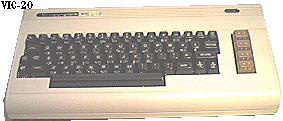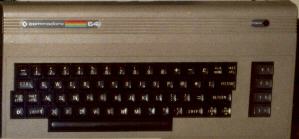History of computer design: Commodore VIC-20
& 64
4-frogdesign || 5-Corporate focus || Conclusion || Bibliography & links
![]()
![]()
 In 1980,
Commodore introduced the VIC-20, a computer more clearly
designed for a broad audience than its previous
PET. The VIC-20, like the
TRS-80, had its circuitboard in the
same rectangular unit as its keyboard. It was small enough
to hold comfortably on the lap, and was designed to be
connected to a television set. Although its white plastic
case was a little crude and toy-like, its price of $299 made
it enormously popular; it was the first model of personal
computer to sell more than one million units
(Smarte, 380). This
was driven largely by its use to play games. ROM cartridges
could be plugged easily into the slot at the back of the
keyboard unit, giving the computer an arcade-style game
without the need to type commands. This association with
entertainment, fostered as much by its insubstantial
toy-like case as by its relative lack of processing power,
helped inspire game machines for the home from companies
such as Nintendo a
In 1980,
Commodore introduced the VIC-20, a computer more clearly
designed for a broad audience than its previous
PET. The VIC-20, like the
TRS-80, had its circuitboard in the
same rectangular unit as its keyboard. It was small enough
to hold comfortably on the lap, and was designed to be
connected to a television set. Although its white plastic
case was a little crude and toy-like, its price of $299 made
it enormously popular; it was the first model of personal
computer to sell more than one million units
(Smarte, 380). This
was driven largely by its use to play games. ROM cartridges
could be plugged easily into the slot at the back of the
keyboard unit, giving the computer an arcade-style game
without the need to type commands. This association with
entertainment, fostered as much by its insubstantial
toy-like case as by its relative lack of processing power,
helped inspire game machines for the home from companies
such as Nintendo a nd Sega.
When Commodore's somewhat more powerful follow-up to the
VIC-20, the Commodore 64, appeared in 1982, it became even
more popular than the VIC-20. However, despite the new sober
grey colour of its otherwise nearly identical plastic case,
the Commodore 64 was also associated closely with games. The
simple rectangular slab design of Commodore's keyboard
computers was no longer used by the late 1980s, and
Commodore's years of success ended as separate physical
design standards emerged for personal computers and for home
arcade game machines.
nd Sega.
When Commodore's somewhat more powerful follow-up to the
VIC-20, the Commodore 64, appeared in 1982, it became even
more popular than the VIC-20. However, despite the new sober
grey colour of its otherwise nearly identical plastic case,
the Commodore 64 was also associated closely with games. The
simple rectangular slab design of Commodore's keyboard
computers was no longer used by the late 1980s, and
Commodore's years of success ended as separate physical
design standards emerged for personal computers and for home
arcade game machines.
To the Macintosh
Revolution (1983-85)![]()
Home || Introduction || Historiography || 1-Cottage industry || 2-Emerging standards || 3-Macintosh
4-frogdesign || 5-Corporate focus || Conclusion || Bibliography & links







.jpg)








